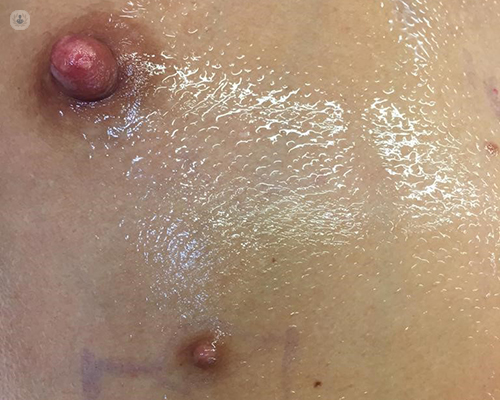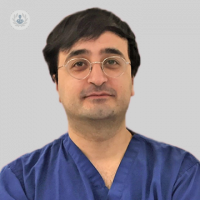What is a third nipple?
Written by:Highly skilled plastic surgeon Mr Brian Simons who has expert knowledge on third nipple, explains the condition and how a third nipple can be removed.
What is a third nipple?
A supernumerary nipple, more commonly known as a ‘third nipple’, is a condition which can arise in both men and women. Statistics surrounding the number of people who have this condition have not been established because it is often misdiagnosed as a mole.

Supernumerary nipples can fall into several different categories depending on their size, shape, and makeup.
Category 1 (Polymastia)
The extra nipple has an areola around it (the soft, circular tissue around a nipple) and typical breast tissue underneath. This signifies that a full breast has developed.
Category 2
In this case, the extra nipple has breast tissue underneath but there is no areola.
Category 3
The extra nipple area has breast tissue underneath but no nipple.
Category 4
The extra nipple has breast tissue underneath but there is no nipple or areola present.
Category 5 (Pseudomamma)
There is an areola around the extra nipple but there is only fat tissue underneath, rather than breast tissue.
Category 6 (Polythelia)
The extra nipple appears by itself with no areola or breast tissue underneath.
Why do third nipples occur?
Third nipples are produced while the embryo is developing in the womb.
During the fourth week of pregnancy, the embryo’s two milk lines, which are made of ridged ectoderm tissue (a type of tissue that eventually becomes part of your skin), thicken.
Normally, the milk line tissue stays thick and works to form your nipples, while the rest of the thickened skin softens up again. However, in some cases, parts of the milk line ridges don’t become regular ectoderm tissue again.
Supernumerary nipples can develop where the milk tissue stays thick and ridged, after birth and development into adulthood. It is possible for supernumerary nipples to lactate in both men and women, particularly if/ when they are more fully developed.
Furthermore, some third nipples which are known as ectopic supernumerary nipples can appear anywhere on the body - even on hands and feet.
It is important to pay close attention if you have a third nipple because, in some cases, they are a sign of a congenital breast defect or an early stage of malignant tumour. Scaramanga’s gene can also induce the third nipple to develop breast cancer in the same way as a regular breast. In addition, a category six third nipple (polythelia) may be related to kidney conditions such as end-stage renal disease or cancer in the kidney cells.
When do I need to see a doctor about my third nipple?
It is advisable to see a doctor if your extra nipple begins to lactate or radiate pain, as this may signify that there is a need for treatment. It is possible for the nipple to form new lumps, hard tissue, or a rash, therefore it is a good idea for them to be checked. Furthermore, it is essential to see a doctor if there is any abnormal discharge or leaks from the third nipple.
Seeing your doctor regularly to monitor the condition of the third nipple is advised in order to detect any abnormalities in the early stages.
What does the third nipple removal procedure involve?
Removing a third nipple is a simple procedure which is performed safely under local anaesthetic. A small incision is made to remove the nipple, as well as any excess breast or fat tissue. The incision site is usually small, with the aim to minimise scarring, and the procedure generally lasts around 30-40 minutes. It's done as a day-case procedure, meaning that patients can have the procedure and return home the same day as soon as the effects of the anaesthesia have worn off.
Swelling around the surgery area will remain for a couple of weeks (perhaps longer in some cases) and the initial redness and bruising will last for a few days. Most surgical sutures are dissolvable and will be naturally absorbed in the first few days, therefore it is unnecessary to return to the clinic, unless there are complications.
If you require a third nipple removal procedure and would like to book a consultation with Mr Simons, do not hesitate to do so by visiting his Top Doctors profile today.


